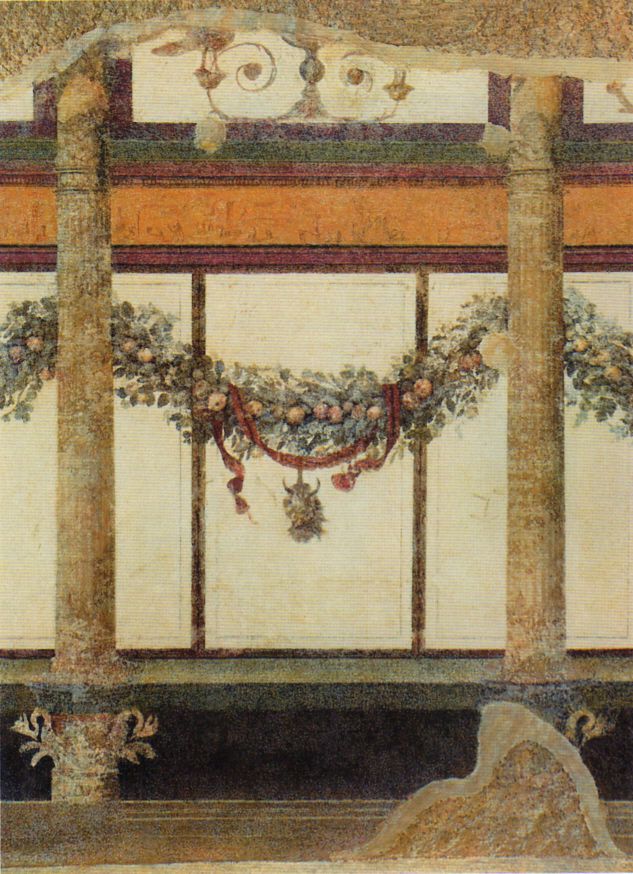Four Styles Roman Wall Painting Years

Lecture 8 - Exploring Special Subjects on Pompeian Walls Overview. Professor Kleiner discusses special subjects in Roman wall painting that do not fall within the four architectural styles but were nonetheless inserted into their wall schemes: mythological painting, landscape, genre, still life, history painting, and painted portraiture.
Four styles roman wall painting years. The first of the four styles is called Incrustation and dates back from 200 to 60 B.C. This style is identified by colorful blocks painted on the wall to resemble large marble slabs. Often, the plaster on the wall is molded into raised backs, adding to the so-called “marbleizing” effect. Roman wall painting is usually grouped into four Pompeian styles of which the first, which imitated slabs of coloured marbles, originated a couple of centuries before the Christian era and reached its apogee around 100BC; the second style in which the "marble slabs" are combined with monumental columns beyond which can be glimpsed realistic. The art of frescoes, as practiced over 2,000 years ago, proves to be both stylistically interesting and practically significant. Roman wall paintings developed into distinct styles over the years, recognizable by viewers today. Bibliography Wallace-Hadrill, Andrew. Houses and Society in Pompeii and Herculaneum. But it is thanks to the ancient Roman city of Pompeii that we can trace the history of Roman wall painting. The entire city was buried in volcanic ash in 79 C.E. when the volcano at Mount Vesuvius erupted, thus preserving the rich colors in the paintings in the houses and monuments there for thousands of years until their rediscovery.
During the Christian epoch, the division of the Roman Empire into a weak Western Roman Empire (based in Ravenna and Rome) and a strong Eastern Roman Empire (based in Constantinople), led to changes in Late Roman art. While wall painting, mosaic art, and funerary sculpture thrived, life-size statues and panel painting dwindled. In 1882, German scholar August Mau published his History of Decorative Wall Painting in Pompeii, creating a system for categorizing 200 years’ worth of frescoes into a range of four decorative styles. His work still provides the standard framework for the study of ancient Roman painting. Lecture 7 - Gilding the Lily: Painting Palaces and Villas in the First Century A.D. Overview. Professor Kleiner discusses the development of Third Style Roman wall painting in late first century B.C. villas belonging to the imperial family and other elite patrons. Art historians have identified _____ different styles of Roman wall painting. Four True or False: Stoicism is a Roman philosophy whose best known practitioners were Epictetus and Marcus Aurelius.
The painting looks spectacular and shows a few children holding Theseus’s hand and congratulating him for killing the mythological beast-Minotaur. This is one of the few ancient paintings of Rome to have been restored in fine shape. Many copies have been made after the original fresco painting. 2. The Roman painting of Omphale 23.) Roman wall painting is described as having four distinct styles, identified from the wall paintings found at Pompeii, Herculaneum, Boscoreal and other cities buried under the volcanic ash of Mt. Vesuvius. Roman mosaics either imitated the painting styles or became very abstract. 24.) The first scholar to classify the Pompeian painting was the German archaeologist August Mau that stood out in four styles.. The first style, referring to the period from III to I century BC, of Greek origin, structural style or fouling, was an imitation stucco, often in relief, the technique called opus quadratum, used to coat the marbles exterior walls of public buildings and religious in the. The Second Style in Roman wall painting started in the early first century 90-25BCE which coincides with the establishment of Pompeii as a Roman settlement but it is known that there are earlier examples in Rome so it would have spread from Rome to Pompeii around this time.
The high number of Roman copies of Greek art also speaks of the esteem Roman artists had for Greek art, and perhaps of its rarer and higher quality. Many of the art forms and methods used by the Romans – such as high and low relief, free-standing sculpture, bronze casting, vase art, mosaic, cameo, coin art, fine jewelry and metalwork, funerary sculpture, perspective drawing, caricature. The types of painting may be dependent on the colour or the paint used which is mainly dependent on the miscibility, drying time and the solubility of particular media. More than anything, it carries a cultural meaning and most reflect thoughts about the society and ides of the mind. Different Types of Painting Styles: While Roman painters used several methods for painting the walls of large homes, the fresco method, which involves painting the wall while the plaster is still wet, is among the most recognized today. Roman frescoes use vibrant colors to depict images of family members, scenery from Roman mythology or outdoor scenes that have only decorative value. The formal Egyptian canon varied little for nearly three thousand years and was to be adapted and enriched in Minoan frescoes, the forerunners of a freer Greek style of painting. Egyptian wall painting was done directly on limestone or on a coat of dried plaster; unlike the Minoan and later Roman wall paintings which were worked in true fresco.



















